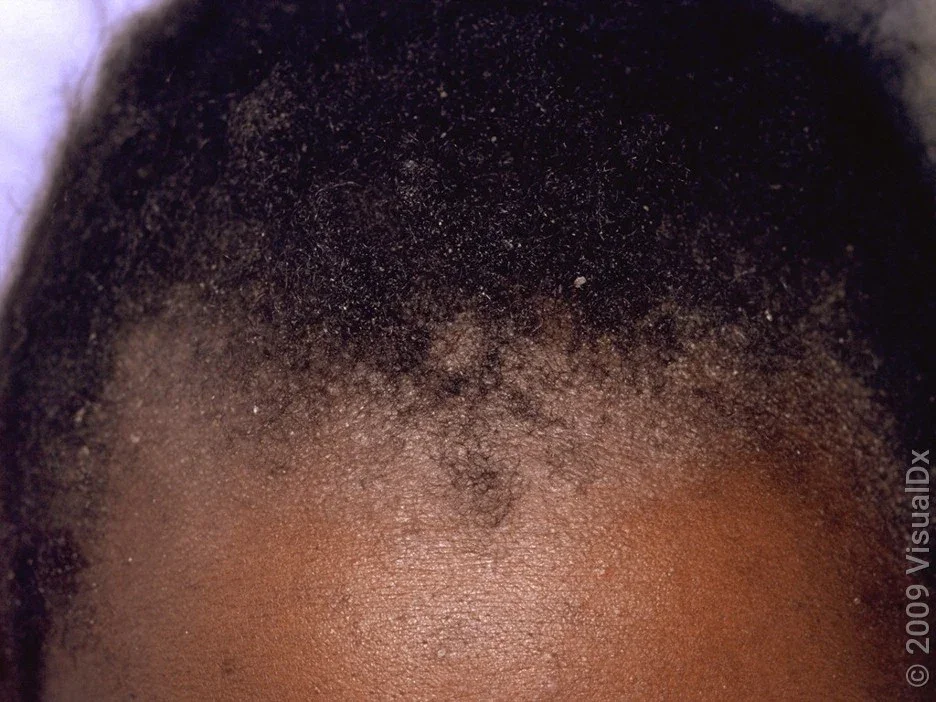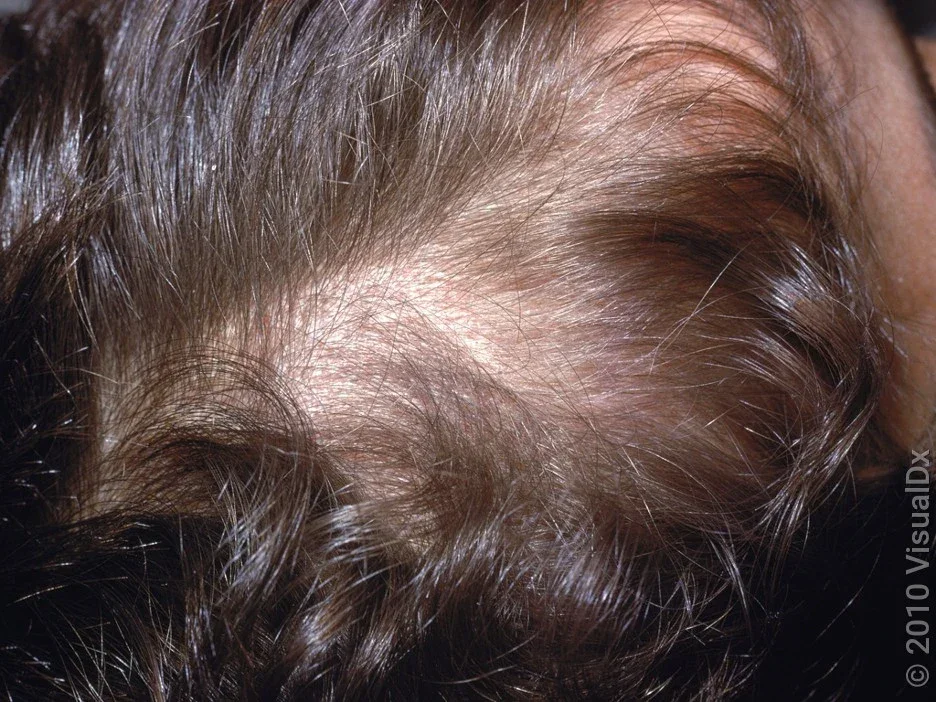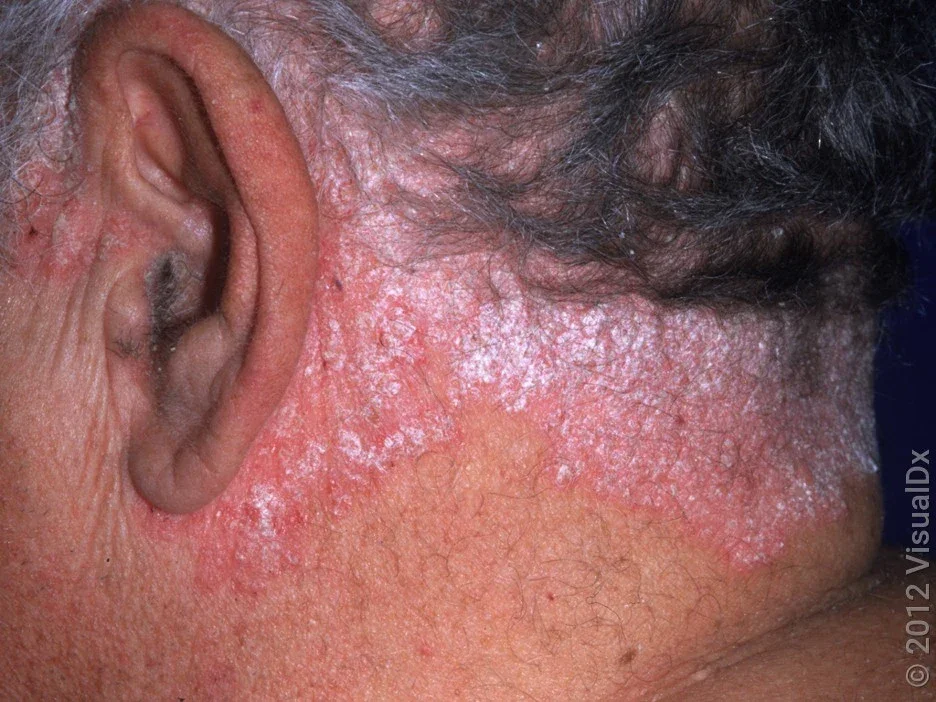Key takeaways:
Scalp psoriasis is a chronic skin condition that causes thick, scaly patches on the scalp and around the hairline, called plaques.
People with scalp psoriasis may have psoriasis on other areas of skin, including the nails.
Having scalp psoriasis can increase your risk of developing a type of joint inflammation called psoriatic arthritis.
You can help improve scalp psoriasis with proper skin care and different medications.
Save on related medications
Psoriasis is a chronic skin condition that can cause itchy rashes across your body — including your scalp. In fact, as many as 9 in 10 people with psoriasis experience scalp symptoms at some point in their lives.
Scalp psoriasis can sometimes be mistaken for other conditions that cause scalp flaking (like dandruff and eczema). But, there are some specific clues to look for to help you know that you have psoriasis. Here’s a closer look at scalp psoriasis, including what it looks like (with pictures).
What is scalp psoriasis?
Scalp psoriasis is psoriasis that affects the skin on the head. It’s not a type of psoriasis. It just describes the location of the psoriasis.
Psoriasis is a chronic condition that can affect skin anywhere on the body, including the scalp. It’s an autoimmune condition in which an overactive immune system causes skin cells to grow too fast. This leads to the formation of thick, discolored skin patches (called plaques). People who have psoriasis on the scalp may be at increased risk of developing the joint disease psoriatic arthritis.
What does scalp psoriasis look like?
In fair skin, scalp psoriasis plaques are thick patches of skin that are usually pink or red with white scales. In darker skin tones, plaques can be violet, brown, or skin-colored with white or gray scales. Plaques can be within the hair and around the hairline. Sometimes they go beyond the hairline onto the surrounding skin.
Scalp psoriasis pictures
Here are some pictures of scalp psoriasis in different skin tones.




Symptoms of scalp psoriasis
In addition to skin plaques, scalp psoriasis can cause other symptoms, including:
Dry and flaking skin
Scalp burning or soreness
Itching
Bleeding
Hair loss or thinning (this is temporary)
What causes scalp psoriasis?
The cause of scalp psoriasis is the same as psoriasis on any other part of the body: Skin cells multiply too fast — over days rather than weeks. Instead of shedding dead cells slowly, they pile up into plaques and scales.
It’s not clear exactly why some people develop psoriasis. But genetics and the immune system seem to play a role.
Certain environmental triggers can cause psoriasis to flare. These include:
Cold, dry weather
Stress
Certain infections (like strep throat)
Stopping systemic steroids
Injuries to the skin, like cuts, scratches, or tattoos
Scalp psoriasis or dandruff? Learn how to tell the difference between these two common scalp conditions — with pictures.
Psoriasis on Black skin: See what psoriasis looks like in darker skin tones.
Common psoriasis triggers: From medications to certain foods, here are the most common triggers for a psoriasis flare.
How is scalp psoriasis diagnosed?
A dermatologist can usually diagnose scalp psoriasis just by looking at your rash and asking you questions about your symptoms.
Sometimes, a skin biopsy is needed to confirm this diagnosis. In this minor office procedure, a dermatologist numbs your skin and removes a small sample of affected skin. This sample gets sent to a lab where a skin disease specialist (dermatopathologist) examines the skin cells under a microscope.
How do you treat scalp psoriasis?
Most of the time, scalp psoriasis can be treated just with topical medications. These are treatments you apply directly to the scalp, like medicated shampoos, creams, and ointments. Depending on how severe your symptoms are, you may also need to add other treatments like light therapy, or whole-body medications like pills, shots, or infusions. Let’s look at each of these types of treatments in turn.
Read more like this
Explore these related articles, suggested for readers like you.
Topical treatments for scalp psoriasis
Most topical treatments for scalp psoriasis come as shampoos, liquids, and foams.
These are easier to apply in areas where there’s hair. Here are some common topical treatments for scalp psoriasis.
OTC medicated shampoos
Over-the-counter (OTC) medicated shampoos are a good starting point for scalp psoriasis. They can be used alone or with other medications. Look for shampoos that contain these ingredients:
Salicylic acid (like DHS Sal Shampoo), which helps break apart psoriasis scales
Coal tar (like Neutrogena T/Gel), which helps slow down cell growth
Topical steroids
Topical steroids work by calming inflammation and improving psoriasis symptoms. Some common topical steroids include:
Shampoos: clobetasol propionate 0.05% shampoo (Clobex)
Liquids: clobetasol propionate 0.05% solution, fluocinonide solution, desoximetasone 0.25% spray (Topicort spray)
Foams: clobetasol propionate 0.05% foam, betamethasone valerate 0.12% foam
It’s not safe to use topical steroids continuously. They’re usually used for 2 to 4 weeks at a time and can be rotated with other topical treatments. Side effects of topical steroids can include:
Skin irritation (like burning or stinging)
Thinning of the skin
Broken blood vessels
Topical vitamin D analogs
Topical vitamin D analogs are medications that slow the rapid cell turnover in psoriasis. They’re useful in a rotation with topical steroids. By alternating medications, it’s possible to maximize their effect while lowering the risk of steroid side effects.
Available vitamin D analogs include:
Solutions: calcipotriene 0.005% solution (Dovonex)
Foams: calcipotriene 0.005% foam (Sorilux)
Combination products
Some products combine both betamethasone (a topical steroid) and calcipotriene. Studies show that these may work better than either type of medication alone. Examples of combination products include:
Taclonex (betamethasone / calcipotriene) suspension
Enstilar (betamethasone / calcipotriene) foam
Wynzora (betamethasone / calcipotriene) cream
Since these products contain a steroid, there’s a risk of steroid side effects. You shouldn’t use these medications for more than 8 weeks at a time.
Light therapy
Light therapy (also called phototherapy) uses certain wavelengths of ultraviolet (UV) light to treat psoriasis.
For scalp psoriasis and psoriasis around the hairline, a type of light therapy called the excimer laser is especially effective. This handheld device delivers a narrow, painless beam of high-intensity UVB light to the scalp through parted hair. In one study on the excimer laser, symptoms improved in 11 out of 20 people with scalp psoriasis who got the treatment.
This laser treatment is delivered in your doctor’s office. For it to be effective, you need to have treatment 2 to 3 times a week. You can have excimer laser treatment in combination with other treatments.
Systemic treatments
In rare situations, scalp psoriasis needs treatment with whole-body (systemic) medications like pills or injections. This can happen if you have severe scalp psoriasis, psoriasis in other areas of the skin, or psoriasis affecting your joints (psoriatic arthritis).
Oral medications (pills)
Oral medications (pills) that treat scalp psoriasis include:
Immunosuppressants, like methotrexate (Trexall) and cyclosporine (Sandimmune), which prevent the immune system overactivity that contributes to psoriasis
Acitretin, a form of vitamin A that slows cell turnover to help clear psoriasis
Apremilast (Otezla), a newer medicine that decreases inflammation inside cells
Biologics
Biologic medications are immune therapies that come as injections or infusions. They’ve revolutionized the treatment of many inflammatory diseases, including psoriasis.
Examples of biologics used to treat moderate to severe plaque psoriasis are:
If you need a biologic, your dermatologist will guide you on which one is best for you. They’ll consider whether you have joint symptoms, the dosing schedule, and what your insurance will cover.
Self-care and home remedies for scalp psoriasis
Treating scalp psoriasis starts with good scalp skin care to help keep your scalp and hair healthy. Here are some tips for what that means in practice:
Use a shampoo that softens the scale, like a salicylic-acid-based shampoo.
Gently brush the scale away with a comb while your scalp is still wet after shampooing. Be careful not to damage the scalp.
Use a conditioner every time you wash your hair, to help add moisture and counteract dryness caused by medications.
Use a humidifier in the winter, to avoid drying out your skin and hair.
Don’t pick — picking can cause psoriasis to intensify and create scarring.
Avoid blow-drying with hot air, which can dry out skin and hair. (Use cool air, if needed.)
Avoid tight hairstyles.
Minimize hair coloring, perms, and relaxers.
Try a natural solution, like a 0.5% aloe vera cream, to reduce redness and scaling.
You can also try a 1:1 apple cider vinegar and water solution, to reduce itching.
Preventing scalp psoriasis
Scalp psoriasis is a chronic condition, so it’s not always possible to prevent it. But, you can minimize symptoms and keep flares at bay by sticking to your treatment plan and practicing good scalp care. If despite this, you still experience symptoms, let your healthcare team know. They can help you adjust your treatment approach.
Frequently asked questions
Scalp psoriasis and dandruff can both cause itchy flakes, but they’re separate conditions. Psoriasis is a chronic autoimmune skin condition that causes thick plaques. Dandruff, on the other hand, is caused by an overreaction to a yeast that normally lives on the skin. Instead of plaques, it causes yellow or white greasy flakes.
Psoriasis and eczema are two common conditions that cause itchy patches on the skin. But they have different causes. They also show up in slightly different places on the body:
Eczema usually involves skin folds, like the neck, behind the knees, and the inside of the arm.
Psoriasis typically affects the scalp, elbows, and knees.
There’s no cure for psoriasis. But medications can help clear the skin plaques and improve symptoms. Avoiding psoriasis triggers is also an important way to keep skin symptoms from flaring up.
Scalp psoriasis can sometimes cause temporary hair loss. When the skin plaques get too thick, they can stop hair from growing. Once the plaques are treated, hair usually grows back. To reduce your risk of hair loss, gently brush the scale away to stop it from building up. But avoid picking or scratching at your skin: This can lead to scarring, which can also cause hair to stop growing.
No. Scalp psoriasis isn’t an infection, and it’s never contagious. You can’t get psoriasis from touching it or from someone who has it.
Scalp psoriasis and dandruff can both cause itchy flakes, but they’re separate conditions. Psoriasis is a chronic autoimmune skin condition that causes thick plaques. Dandruff, on the other hand, is caused by an overreaction to a yeast that normally lives on the skin. Instead of plaques, it causes yellow or white greasy flakes.
Psoriasis and eczema are two common conditions that cause itchy patches on the skin. But they have different causes. They also show up in slightly different places on the body:
Eczema usually involves skin folds, like the neck, behind the knees, and the inside of the arm.
Psoriasis typically affects the scalp, elbows, and knees.
There’s no cure for psoriasis. But medications can help clear the skin plaques and improve symptoms. Avoiding psoriasis triggers is also an important way to keep skin symptoms from flaring up.
Scalp psoriasis can sometimes cause temporary hair loss. When the skin plaques get too thick, they can stop hair from growing. Once the plaques are treated, hair usually grows back. To reduce your risk of hair loss, gently brush the scale away to stop it from building up. But avoid picking or scratching at your skin: This can lead to scarring, which can also cause hair to stop growing.
No. Scalp psoriasis isn’t an infection, and it’s never contagious. You can’t get psoriasis from touching it or from someone who has it.
The bottom line
If you have redness, itching, or flaking in your scalp, see your primary care provider or a dermatologist. These could be signs of scalp psoriasis. Most of the time, scalp psoriasis can be treated with medicated foams and/or shampoos, and good scalp care. But scalp psoriasis can look similar to dandruff and scalp eczema, so it’s important to get the diagnosis right.

Why trust our experts?



Images used with permission from VisualDx (www.visualdx.com).
References
American Academy of Dermatology Association. (n.d.). Scalp psoriasis: 10 ways to reduce hair loss.
Busse, K., et al. (2010). Which psoriasis patients develop psoriatic arthritis? Psoriasis Forum.
Coondoo, A., et al. (2014). Side-effects of topical steroids: A long overdue revisit. Indian Dermatology Online Journal.
Dopytalska, K., et al. (2018). Psoriasis in special localizations. Reumatologia.
National Psoriasis Foundation. (2020). Integrative approaches to care.
National Psoriasis Foundation. (2023). Over-the-counter topicals.
National Psoriasis Foundation. (2025). Medicated psoriasis shampoos your scalp will love.
National Psoriasis Foundation. (2025). Phototherapy for psoriasis.
National Psoriasis Foundation. (2025). Scalp psoriasis.
Patel, D. S., et al. (2020). Efficacy of fixed-combination calcipotriene 0.005% and betamethasone dipropionate 0.064% foam for scalp plaque psoriasis: Additional analysis of a phase ii, randomized clinical study. The Journal of Clinical and Aesthetic Dermatology.
Rattanakaemakorn, P., et al. (2019). Efficacy and safety of 308-nm excimer lamp in the treatment of scalp psoriasis: A retrospective study. Photodermatology, Photoimmunology & Photomedicine.
Wong, J. W., et al. (2012). Excimer laser therapy for hairline psoriasis: A useful addition to the scalp psoriasis treatment algorithm. Skin Therapy Letter.
















